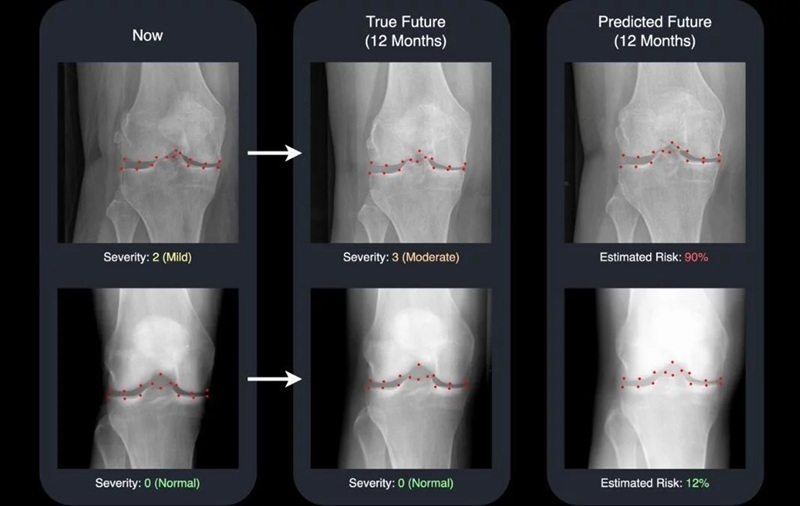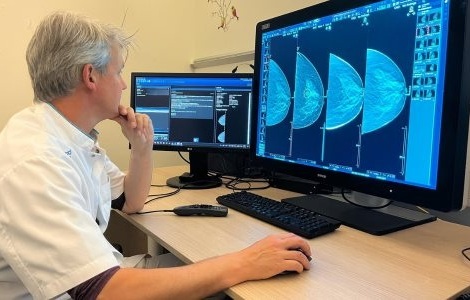Restriction Spectrum MRI Technique Improves Diagnosis of Prostate Cancer
|
By MedImaging International staff writers Posted on 21 Jan 2015 |
New magnetic resonance imaging (MRI) technology could soon translate into more effective diagnoses and less invasive interventions for prostate cancer.
Investigators have recently reported on the innovative imaging technique, which measurably improves upon current prostate imaging, and may have significant implications for how patients with prostate cancer are ultimately treated.
Prostate cancer was the leading cause of newly diagnosed cancers in men and the second leading cause of cancer death in men in 2014. The group of scientists and physicians, from the University of California (UC), San Diego School of Medicine (USA), with colleagues at University of California, Los Angeles (UCLA; USA), published their findings in the January 6, 2015, issue of the journal Prostate Cancer and Prostatic Disease. “This new approach is a more reliable imaging technique for localizing tumors. It provides a better target for biopsies, especially for smaller tumors,” said Rebecca Rakow-Penner, MD, PhD, a research resident in the department of radiology and the study’s first author.
The technique is also beneficial in surgical planning and image staging, according to David S. Karow, MD, PhD, assistant professor of radiology at UC San Diego, and the study’s corresponding author. “Doctors at UC San Diego and UCLA now have a noninvasive imaging method to more accurately assess the local extent of the tumor and possibly predict the grade of the tumor, which can help them more precisely and effectively determine appropriate treatment.”
The current standard of care for detecting and diagnosing prostate cancer is contrast-enhanced magnetic resonance imaging (MRI), which involves intravenously injecting patients with a contrast agent to highlight blood flow. Greater blood flow is often a requirement of growing cancer cells. When compared to surrounding healthy tissues, it is hoped that contrast-enhanced MRI scans will reveal the shape and composition of any tumors present.
But many tumors do not significantly differ from surrounding healthy tissues with contrast enhanced MRI and so evade easy detection. An imaging technique called diffusion MRI measures the diffusion of water and has been a standard imaging technique in the brain and an emerging technique in the prostate. Cancer tissues are denser than healthy tissues and typically limit the amount and mobility of water within them. However, diffusion MRI suffers from magnetic field artifacts that can distort the actual location of tumors by as much as 1.2 cm—a substantial distance when surgeons are trying, for instance, to evaluate whether a tumor extends beyond the prostate and into adjacent nerve bundles.
The new imaging strategy in the study is called restriction spectrum imaging-MRI (RSI-MRI). It corrects for magnetic field distortions and focuses upon water diffusion within tumor cells. By doing both, the ability of imaging to accurately plot a tumor’s location is increased and there is a more refined sense of the tumor’s extent, according to Nathan White, PhD, assistant project scientist at UC San Diego, study coauthor, and co-inventor of the RSI-MRI technique.
In a related study to be published in the journal Frontiers in Oncology, the same researchers reported that RSI-MRI appears to predict tumor grade. Higher grade tumors correlate with higher restricted water volume in the cancer cells’ large nuclei. “Prostate cancer can often be an indolent disease, where a patient may only require surveillance rather than aggressive surgery,” noted coauthor Christopher J. Kane, MD, professor of urology at UC San Diego.
“If by imaging we could predict the tumor grade,” added Robert Reiter, MD, professor of urology at UCLA, “we may be able to spare some patients from prostate resection and monitor their cancer with imaging.”
Related Links:
University of California, San Diego
University of California, Los Angeles
Investigators have recently reported on the innovative imaging technique, which measurably improves upon current prostate imaging, and may have significant implications for how patients with prostate cancer are ultimately treated.
Prostate cancer was the leading cause of newly diagnosed cancers in men and the second leading cause of cancer death in men in 2014. The group of scientists and physicians, from the University of California (UC), San Diego School of Medicine (USA), with colleagues at University of California, Los Angeles (UCLA; USA), published their findings in the January 6, 2015, issue of the journal Prostate Cancer and Prostatic Disease. “This new approach is a more reliable imaging technique for localizing tumors. It provides a better target for biopsies, especially for smaller tumors,” said Rebecca Rakow-Penner, MD, PhD, a research resident in the department of radiology and the study’s first author.
The technique is also beneficial in surgical planning and image staging, according to David S. Karow, MD, PhD, assistant professor of radiology at UC San Diego, and the study’s corresponding author. “Doctors at UC San Diego and UCLA now have a noninvasive imaging method to more accurately assess the local extent of the tumor and possibly predict the grade of the tumor, which can help them more precisely and effectively determine appropriate treatment.”
The current standard of care for detecting and diagnosing prostate cancer is contrast-enhanced magnetic resonance imaging (MRI), which involves intravenously injecting patients with a contrast agent to highlight blood flow. Greater blood flow is often a requirement of growing cancer cells. When compared to surrounding healthy tissues, it is hoped that contrast-enhanced MRI scans will reveal the shape and composition of any tumors present.
But many tumors do not significantly differ from surrounding healthy tissues with contrast enhanced MRI and so evade easy detection. An imaging technique called diffusion MRI measures the diffusion of water and has been a standard imaging technique in the brain and an emerging technique in the prostate. Cancer tissues are denser than healthy tissues and typically limit the amount and mobility of water within them. However, diffusion MRI suffers from magnetic field artifacts that can distort the actual location of tumors by as much as 1.2 cm—a substantial distance when surgeons are trying, for instance, to evaluate whether a tumor extends beyond the prostate and into adjacent nerve bundles.
The new imaging strategy in the study is called restriction spectrum imaging-MRI (RSI-MRI). It corrects for magnetic field distortions and focuses upon water diffusion within tumor cells. By doing both, the ability of imaging to accurately plot a tumor’s location is increased and there is a more refined sense of the tumor’s extent, according to Nathan White, PhD, assistant project scientist at UC San Diego, study coauthor, and co-inventor of the RSI-MRI technique.
In a related study to be published in the journal Frontiers in Oncology, the same researchers reported that RSI-MRI appears to predict tumor grade. Higher grade tumors correlate with higher restricted water volume in the cancer cells’ large nuclei. “Prostate cancer can often be an indolent disease, where a patient may only require surveillance rather than aggressive surgery,” noted coauthor Christopher J. Kane, MD, professor of urology at UC San Diego.
“If by imaging we could predict the tumor grade,” added Robert Reiter, MD, professor of urology at UCLA, “we may be able to spare some patients from prostate resection and monitor their cancer with imaging.”
Related Links:
University of California, San Diego
University of California, Los Angeles
Latest MRI News
- Novel Imaging Approach to Improve Treatment for Spinal Cord Injuries
- AI-Assisted Model Enhances MRI Heart Scans
- AI Model Outperforms Doctors at Identifying Patients Most At-Risk of Cardiac Arrest
- New MRI Technique Reveals Hidden Heart Issues
- Shorter MRI Exam Effectively Detects Cancer in Dense Breasts
- MRI to Replace Painful Spinal Tap for Faster MS Diagnosis
- MRI Scans Can Identify Cardiovascular Disease Ten Years in Advance
- Simple Brain Scan Diagnoses Parkinson's Disease Years Before It Becomes Untreatable
- Cutting-Edge MRI Technology to Revolutionize Diagnosis of Common Heart Problem
- New MRI Technique Reveals True Heart Age to Prevent Attacks and Strokes
- AI Tool Predicts Relapse of Pediatric Brain Cancer from Brain MRI Scans
- AI Tool Tracks Effectiveness of Multiple Sclerosis Treatments Using Brain MRI Scans
- Ultra-Powerful MRI Scans Enable Life-Changing Surgery in Treatment-Resistant Epileptic Patients
- AI-Powered MRI Technology Improves Parkinson’s Diagnoses
- Biparametric MRI Combined with AI Enhances Detection of Clinically Significant Prostate Cancer
- First-Of-Its-Kind AI-Driven Brain Imaging Platform to Better Guide Stroke Treatment Options
Channels
Radiography
view channel
X-Ray Breakthrough Captures Three Image-Contrast Types in Single Shot
Detecting early-stage cancer or subtle changes deep inside tissues has long challenged conventional X-ray systems, which rely only on how structures absorb radiation. This limitation keeps many microstructural... Read more
AI Generates Future Knee X-Rays to Predict Osteoarthritis Progression Risk
Osteoarthritis, a degenerative joint disease affecting over 500 million people worldwide, is the leading cause of disability among older adults. Current diagnostic tools allow doctors to assess damage... Read moreUltrasound
view channel
Wearable Ultrasound Imaging System to Enable Real-Time Disease Monitoring
Chronic conditions such as hypertension and heart failure require close monitoring, yet today’s ultrasound imaging is largely confined to hospitals and short, episodic scans. This reactive model limits... Read more
Ultrasound Technique Visualizes Deep Blood Vessels in 3D Without Contrast Agents
Producing clear 3D images of deep blood vessels has long been difficult without relying on contrast agents, CT scans, or MRI. Standard ultrasound typically provides only 2D cross-sections, limiting clinicians’... Read moreNuclear Medicine
view channel
PET Imaging of Inflammation Predicts Recovery and Guides Therapy After Heart Attack
Acute myocardial infarction can trigger lasting heart damage, yet clinicians still lack reliable tools to identify which patients will regain function and which may develop heart failure.... Read more
Radiotheranostic Approach Detects, Kills and Reprograms Aggressive Cancers
Aggressive cancers such as osteosarcoma and glioblastoma often resist standard therapies, thrive in hostile tumor environments, and recur despite surgery, radiation, or chemotherapy. These tumors also... Read more
New Imaging Solution Improves Survival for Patients with Recurring Prostate Cancer
Detecting recurrent prostate cancer remains one of the most difficult challenges in oncology, as standard imaging methods such as bone scans and CT scans often fail to accurately locate small or early-stage tumors.... Read moreGeneral/Advanced Imaging
view channel
New Algorithm Dramatically Speeds Up Stroke Detection Scans
When patients arrive at emergency rooms with stroke symptoms, clinicians must rapidly determine whether the cause is a blood clot or a brain bleed, as treatment decisions depend on this distinction.... Read more
3D Scanning Approach Enables Ultra-Precise Brain Surgery
Precise navigation is critical in neurosurgery, yet even small alignment errors can affect outcomes when operating deep within the brain. A new 3D surface-scanning approach now provides a radiation-free... Read moreImaging IT
view channel
New Google Cloud Medical Imaging Suite Makes Imaging Healthcare Data More Accessible
Medical imaging is a critical tool used to diagnose patients, and there are billions of medical images scanned globally each year. Imaging data accounts for about 90% of all healthcare data1 and, until... Read more
Global AI in Medical Diagnostics Market to Be Driven by Demand for Image Recognition in Radiology
The global artificial intelligence (AI) in medical diagnostics market is expanding with early disease detection being one of its key applications and image recognition becoming a compelling consumer proposition... Read moreIndustry News
view channel
GE HealthCare and NVIDIA Collaboration to Reimagine Diagnostic Imaging
GE HealthCare (Chicago, IL, USA) has entered into a collaboration with NVIDIA (Santa Clara, CA, USA), expanding the existing relationship between the two companies to focus on pioneering innovation in... Read more
Patient-Specific 3D-Printed Phantoms Transform CT Imaging
New research has highlighted how anatomically precise, patient-specific 3D-printed phantoms are proving to be scalable, cost-effective, and efficient tools in the development of new CT scan algorithms... Read more
Siemens and Sectra Collaborate on Enhancing Radiology Workflows
Siemens Healthineers (Forchheim, Germany) and Sectra (Linköping, Sweden) have entered into a collaboration aimed at enhancing radiologists' diagnostic capabilities and, in turn, improving patient care... Read more




















